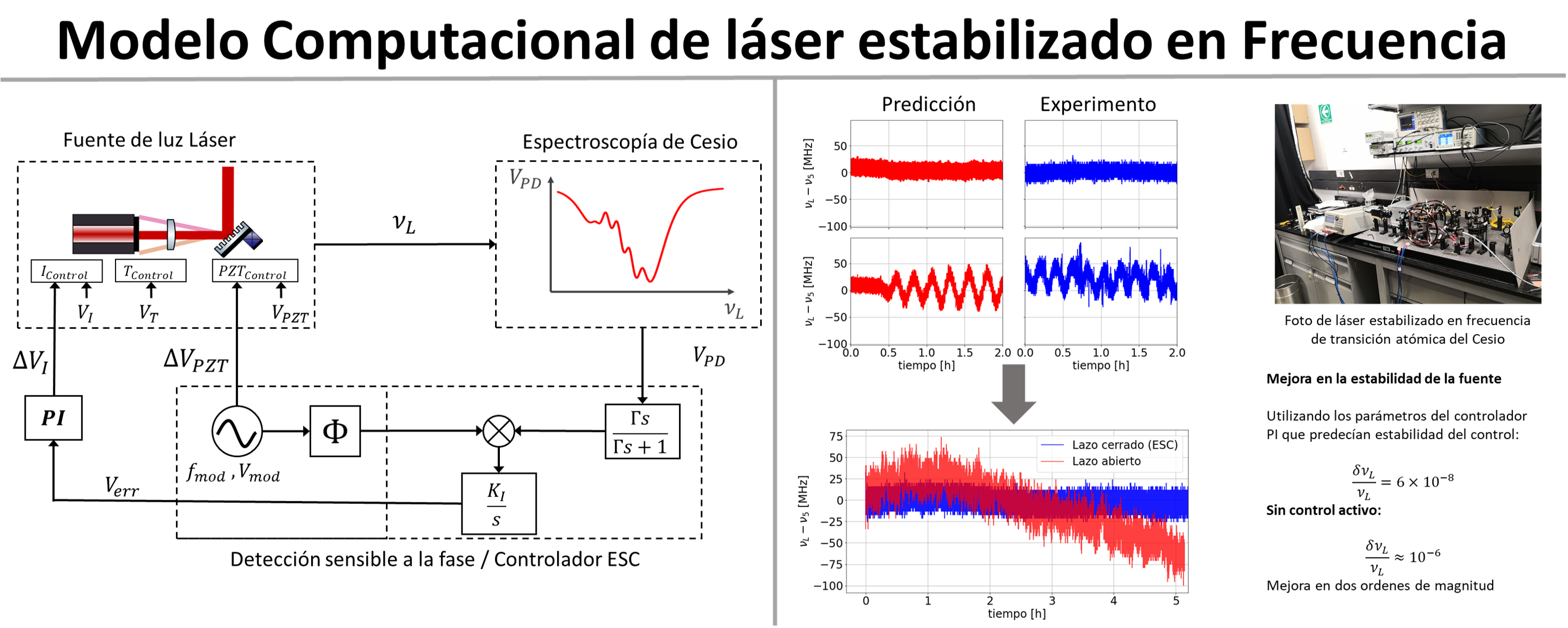Computational model of frequency stabilized laser for Extremum Seeking Controller parameter tuning
Keywords:
Extremum-Seeking Control, Laser frequency stabilization, Control simulationAbstract
Extremum-Seeking Control (ESC) is a technique used to stabilize systems to optimal operating conditions. The adjustment of the controller parameters is not usually reported. In this paper we present a computational model for frequency stabilization of a laser source using ESC. The model is based on a saturated absorption spectroscopy experiment used to reference the frequency of the laser light to an atomic transition in Cesium atoms. By using this model, we were able to study the performance and adjust the parameters of the controlled system. This model was succesfully validated using an experimental open loop configuration. The model was then used to predict stable configurations of the controlled system, to be implemented in the experimental setup. As a result, we were able to get the laser frequency locked to a Cs atomic transition in the laboratory with a relative stability in frequency of 6x10-8.
Downloads
References
D. Miller, “Attojoule optoelectronics for low-energy information pro-cessing and communications.,”Journal of Lightwave Technology,vol. 35, no. 3, pp. 346–396, 2017.
T. Mukaihara, T. Kimura, and H. Koshi, “Narrow linewidth tunablelasers for digital coherent system.,”2015 11th Conference on Lasersand Electro-Optics Pacific Rim (CLEO-PR), Lasers and Electro-OpticsPacific Rim (CLEO-PR), 2015 11th Conference on, vol. 3, pp. 1 – 2,2015.
D. Welch, “A brief history of high-power semiconductor lasers.,”IEEEJournal of Selected Topics in Quantum Electronics, Selected Topics in Quantum Electronics, IEEE Journal of, IEEE J. Select. Topics QuantumElectron, vol. 6, no. 6, pp. 1470 – 1477, 2000.
T. Heavner, S. Jefferts, E. Donley, J. Shirley, and T. Parker, “Recent im-provements in nist-f1 and a resulting accuracy of /spl delta/f/f=0.61/spltimes/10/sup -15/.,”IEEE Transactions on Instrumentation and Mea-surement, Instrumentation and Measurement, IEEE Transactions on,IEEE Trans. Instrum. Meas, vol. 54, no. 2, pp. 842 – 845, 2005.
E. Gibney, “Quantum gold rush: the private funding pouring into quantum start-ups.,”Nature: International weekly journal of science,vol. 574, no. 7776, p. 22, 2019.
J. Stuhler, “Quantum optics route to market.,”Nature Physics, vol. 11,no. 4, pp. 293 – 295, 2015.
S. RITTER and J. STUHLER, “Lasers shape the world of quantumtechnologies., ”Laser Focus World, vol. 56, no. 7, pp. 38 – 40, 2020.
S. Krzyzewski, O. Alem, and S. Knappe, “Mems-enabled quantumatomic magnetometers.,”2021 IEEE 34th International Conference onMicro Electro Mechanical Systems (MEMS), Micro Electro MechanicalSystems (MEMS), 2021 IEEE 34th International Conference on, pp. 256– 259, 2021.
J. J. García-Ripoll and J. I. Cirac, “Quantum computation with coldbosonic atoms in an optical lattice.,”Philosophical Transactions: Mathe-matical, Physical and Engineering Sciences, vol. 361, no. 1808, pp. 1537– 1548, 2003.
T. Numai, Laser diodes and their applications to communicationsand information processing. Wiley series inmicrowave and optical engineering, Wiley, 2010.
A. E. Siegman, An introduction to lasers and masers. New York:McGraw-Hill, 1971.
C. E. Wieman and L. Hollberg, “Using diode lasers for atomic physics, ”Review of Scientific Instruments, vol. 62, no. 1, pp. 1–20, 1991.
T. M. Hard, “Laser wavelength selection and output coupling by agrating,”Appl. Opt., vol. 9, pp. 1825–1830, Aug 1970.
K. B. Ariyur and M. Krstic ,Real time optimization by extremum seeking control. Wiley Interscience, 2003.
S. L. Brunton and J. N. Kutz,Data-Driven Science and Engineering:Machine Learning, Dynamical Systems, and Control. Cambridge University Press, 2019.
F. Bertinetto, P. Cordiale, G. Galzerano, and E. Bava, “Frequency stabilization of dbr diode laser against cs absorption lines at 852nm using the modulation transfer method.,”IEEE Transactions on Instrumentation and Measurement, Instrumentation and Measurement, IEEE Transactions on, IEEE Trans. Instrum. Meas, vol. 50, no. 2,pp. 490 – 492, 2001.
O. Schmidt, K. M. Knaak, R. Wynands, and D. Meschede, “Cesium saturation spectroscopy revisited: How to reverse peaks and observe narrow resonances.,”Applied Physics B: Lasers and Optics, vol. 59, no. 2, p. 167, 1994.
W. Demtröder, Atoms, molecules and photons : an introduction to atomic-, molecular- and quantum physics. Graduate texts in physics,1868-4513, Berlin, Germany: Springer, 2018.
Y. Tan, W. Moase, C. Manzie, D. Nesic, and I. Mareels, “Extremumseeking from 1922 to 2010.,”Proceedings of the 29th Chinese ControlConference, Control Conference (CCC), 2010 29th Chinese, pp. 14 –26, 2010.
W. Nagourney, Quantum Electronics for Atomic Physics and Telecommunication. Oxford Graduate Texts, Oxford University Press, 2014.
C. J. Foot, Atomic physics. Oxford master series in atomic, optical and laser physics, Oxford: Oxford University Press, 2005.
W. Demtröder, Laser spectroscopy 2 : experimental techniques. Berlin:Springer, 2015.
D. A. Steck,Cesium D Line Data (Revisión 2.2.1), disponible en: https://steck.us/alkalidata/cesiumnumbers.pdf. Nov 2019.
N. Manrique Nieto and M. Nuñez Portela, Estabilización en frecuenciade láser centrado en transición atómica de la línea D2 del cesio. Uniandes, 2020.
W. Lee and D. Sullivan, “Cesium beam frequency standards.,”1997IEEE MTT-S International Microwave Symposium Digest, MicrowaveSymposium Digest, 1997., IEEE MTT-S International, Microwave sym-posium, vol. 3, p. 1161, 1997.
W. Demtröder, Laser spectroscopy 1 : basic principles. Berlin: Springer,2014.


